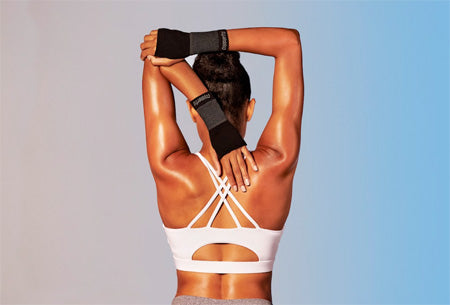
Running a 5k is an exciting challenge that requires dedication, preparation, and the right mindset. Whether you're a seasoned runner or a beginner, training for a 5k run can be a rewarding experience that enhances your physical fitness and mental resilience.
At Copper Fit, we're committed to supporting your comfort and recovery, enabling you to stay active and feel your best every day. We’ll provide you with the knowledge and tools you need to train effectively for a 5k run and enjoy the process.
What Does a 5k Run Entail and Why Should You Consider One?
A 5k run, equivalent to 3.1 miles, is a popular distance for both novice and experienced runners. On average, a beginner might complete a 5k run in 30-40 minutes, while more advanced runners could aim for times under 20 minutes. But why is running a 5k so appealing?
Running a 5k offers numerous benefits. It's a manageable distance that still provides a significant fitness challenge, helping improve cardiovascular health, muscular endurance, and mental resilience. Participating in a 5k run often means being part of a larger community event, fostering a sense of camaraderie and shared achievement.
Moreover, training for and completing a 5k run can be a stepping stone to longer distances, such as 10k runs, half marathons, or even full marathons. It's a great way to set and achieve fitness goals, track your progress, and challenge yourself. Whether you're running for fun, fitness, or competition, a 5k run can be a rewarding and fulfilling experience.
How Should You Prepare for 5k Training?
Before you lace up your running shoes and hit the pavement, it's crucial to prepare adequately. Here's how:
Health Check
Before starting any training program, it's wise to consult with a healthcare professional. They can assess your current fitness level and provide personalized advice to help you train safely and effectively.
Set Realistic Goals
Understanding your current fitness level is key to setting achievable goals. If you're new to running, your initial goal might be to complete the 5k without worrying about your finishing time. As you gain more experience, you can aim to improve your time or run the entire distance without walking.
Nutrition and Hydration
Proper nutrition and hydration play a crucial role in your training. A balanced diet can provide the energy you need for your runs and aid in recovery. Staying hydrated, especially during long runs or in hot weather, helps maintain your performance and prevent dehydration.
Rest and Recovery
Training for a 5k isn't just about the time you spend running. Rest and recovery are equally important. They allow your muscles to repair and strengthen, reducing the risk of overuse injuries. Copper Fit's gear can support your recovery process, providing comfort and maintaining joint health as you prepare for your 5k run.
Preparing for a 5k run is a process. It's both about race day and the progress you make along the way. With the right preparation, you can enjoy the process and achieve your running goals.
What Essential Gear Do You Need for 5k Training?
Choosing the right gear can make a significant difference in your training experience. Here are a few essentials to consider:
Choosing the Right Shoes
Your running shoes are the most critical piece of equipment. They need to provide adequate cushioning and support, suit your running style, and fit comfortably. It's worth visiting a specialized running store where experts can help you find the right pair.
Appropriate Clothing
Dress for comfort and the weather. Moisture-wicking fabrics can keep you dry and comfortable, while layers can help you adjust to changing temperatures. Don't forget about protection from the sun, including hats, sunglasses, and sunscreen.
Supporting Your Training With Compression
Compression socks and other compression gear can help maintain joint health and provide comfort during your training. For instance, Copper Fit's compression gear can offer gentle support during your runs and recovery periods, and keep in mind, our copper-infused products can help reduce odor.
What Does a 5k Training Plan Look Like?
A well-structured training plan gradually increases your running distance and intensity, helping you prepare for the 5k without risking overuse injuries.
Here's a basic outline of a 5k training plan:
Week 1-2: Building a Base
Start with short, manageable runs, interspersed with walking intervals if needed. Aim for three runs per week, and balance your running days with rest days to allow for recovery.
Week 3-4: Increasing Distance
Gradually increase your running distance each week. A good rule of thumb is not to increase your total weekly distance by more than 10% from the previous week.
Week 5-6: Introducing Speed Work
Once you're comfortable running a continuous 5k, you can start incorporating speed work, such as interval training or tempo runs, to improve your pace.
Week 7-8: Taper and Race
In the week leading up to the race, reduce your running volume to allow your body to rest and recover. This period, known as tapering, helps you arrive at the starting line feeling fresh and ready.
Your training plan may vary depending on your current fitness level, previous running experience, and individual goals. Always listen to your body and adjust your training plan as needed to avoid overworking and to maintain a healthy balance between training and recovery.
How Can You Prevent Common Running Injuries?
Running injuries can be a setback in your training, but many can be prevented with the right strategies:
Maintain Proper Running Form
Good running form can help you run more efficiently and reduce the risk of injury. Keep your body upright, your gaze forward, and your shoulders relaxed. Your arms should swing naturally at your sides, and your feet should land directly under your body.
Incorporate Stretching and Warm-Up Exercises
Warming up before your runs and cooling down afterward is essential. A good warm-up raises your body temperature and prepares your muscles for the workout ahead. After your run, stretching can help maintain flexibility and range of motion.
Be Mindful of Overuse
Running too much too soon can lead to overuse injuries. Following a training plan that gradually increases distance and intensity can help prevent this. Never forget that rest and recovery are integral parts of your training.
Also, don’t forget that Copper Fit products can help support your joints and provide comfort during your training and recovery periods.
What Should You Know for Race Day?
Race day can be exciting and nerve-wracking, but with the right preparation, you can ensure it goes smoothly:
Pre-Race Preparation
The night before the race, lay out your gear, hydrate well, and try to get a good night's sleep. On race day, eat a light, easily digestible breakfast, and arrive at the race site early to warm up and familiarize yourself with the start area.
During the Race
Start at a comfortable pace, and try not to get caught up in the initial rush. Don’t forget to hydrate at the water stations, and most importantly, enjoy the experience!
Post-Race Recovery
After the race, take time to cool down and stretch. Rehydrate and eat a balanced meal to replenish your energy stores. Whether it's your first 5k or your tenth, the goal is to enjoy the process. Every runner has their own pace and style, so focus on your progress and celebrate your achievements.
Are You Ready to Start Your 5k Training?
Training for a 5k run is a rewarding process that enhances your physical fitness and mental resilience. With proper preparation, the right gear, a well-structured training plan, and strategies to prevent common running injuries, you're well-equipped to start your 5k training.
It's not just about race day but the progress you make along the way. With Copper Fit supporting your comfort and recovery, you're ready to embark on this exciting challenge.
Always consult with a healthcare professional before starting any new fitness program, and most importantly, enjoy the daily process. Here's to your 5k run!
Sources:
How to Run Properly & Avoid Injury | UT Physicians
The right shoe for walking and running - Harvard Health
Sports and Hydration for Athletes: Q&A with a Dietitian | Johns Hopkins Medicine
The importance of warming up and cooling down - College of Health and Human Sciences





